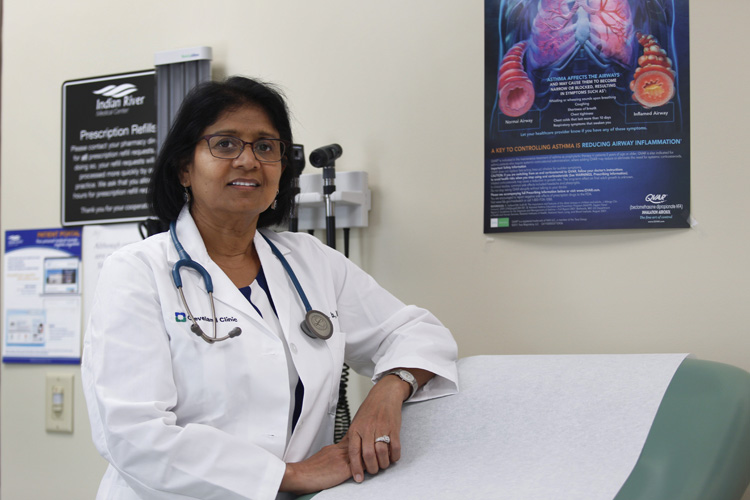
Cancer of the uterus, according the M.D. Anderson Cancer Center of Houston, is the most common cancer of the female reproductive organs, and Dr. Asha Shah of Cleveland Clinic Indian River Hospital’s Pointe West Family Medicine practice says it’s seen often here in Vero Beach.
The uterus is the medical term for a woman’s womb.
It is about the size and shape of an inverted pear and sits quite low in the abdomen held in position by muscles, ligaments and fibrous tissues. It is joined to the vagina by the cervix.
Most women – approximately 92 percent – who develop cancer of the uterus have “endometrial” cancer in which a tumor develops in the tissue of the uterine lining. “Other types of cancer can form in the uterus, including uterine sarcomas, but they are much less common than endometrial cancer, according to the Mayo Clinic.
“With our population,” Shah explains, “I do see a significant number of patients with endometrial cancer. The average risk diagnosis of uterine cancer in the U.S. is [for women over] 62 years.”
“But the risk increases with certain factors,” Shah says, including diabetes and obesity as well as in those receiving certain hormone replacement therapies that include estrogen but not progesterone, as well as certain breast cancer drugs like Tamoxifen and even radiation treatments.
The “good news” is that endometrial cancer is often detected and treated at an early stage because, as M.D. Anderson says, “of warning signs such as abnormal or postmenopausal bleeding.”
Other symptoms may include unusual vaginal discharges that do not have signs of blood; difficult or painful urination; pain during intercourse; pain and/or a mass in the pelvic area; and unintentional weight loss.
“I always try to educate my patients that no matter what their history is, after menopause please do not ignore any [vaginal] bleeding.
“Let me know. All you need is an ultrasound which is painless [and has] no radiation with it and is easy. That might be followed with an endometrial biopsy or a hysteroscopy with D&C.”
A hysteroscopy with D&C – the “D” and the “C” stand for “dilation and curettage” – is “a procedure to remove tissue from inside your uterus. Doctors perform dilation and curettage to diagnose and treat certain uterine conditions,” including endometrial cancer.
When uterine cancer is detected, one of the most common treatments is the surgical removal of the uterus.
A “hysterectomy” (without D&C) is the name of the “surgery to remove a woman’s uterus. During these surgeries, the whole uterus is usually removed. Your doctor may also remove your fallopian tubes and ovaries. After a hysterectomy, you no longer have menstrual periods and cannot become pregnant,” according to the U.S. Department of Health and Human Services.
But assuming your cancer hasn’t spread, you will be cancer-free.
The National Women’s Health Network says “approximately 600,000 hysterectomies are performed annually in the United States, and approximately 20 million American women have had a hysterectomy.”
“By the age of 60, more than one-third of all women have had a hysterectomy,” but NWHN’s executive director, Cindy Pearson, says “I advise any woman who is not in a life-threatening situation to see someone else besides a surgeon to explore nonsurgical options first.”
In other words, it’s important to have detailed conversations with all your medical providers to see if you, personally, have other options and to explore the ramifications of those options closely.
That’s something Shah does with her patients on a regular basis.
Dr. Asha Shah is a family practice physician with the Cleveland Clinic Indian River Hospital’s Pointe West Family Medicine office at 1960 Pointe West Dr., Suite 101. The phone number is 772-564-7828.



